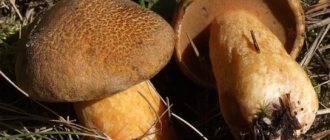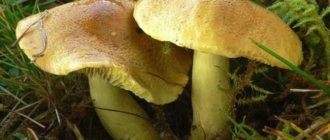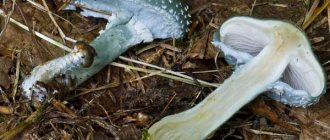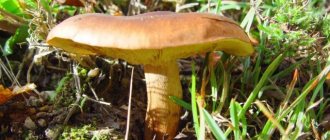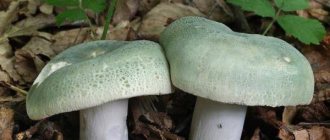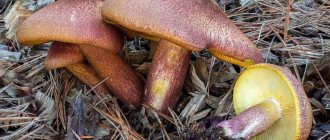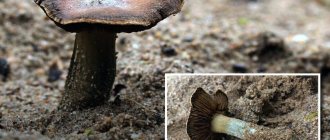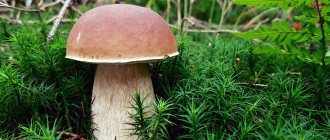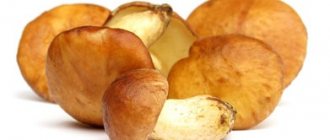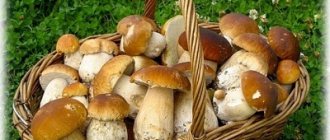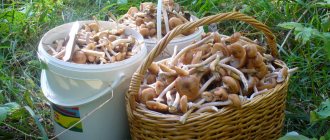| Hygrocybe variegated | |||||||||||||
| Scientific classification | |||||||||||||
Kingdom:
| |||||||||||||
| Latin name | |||||||||||||
| Hygrocybe psittacina (Schaeff.) P. Kumm. 1871 | |||||||||||||
Hygrocybe variegated (lat.
, |
Description
The cap is ∅ 2-5 cm, at first bell-shaped, then gradually acquires a prostrate shape with a wide flattened tubercle in the center. The edges of the cap are ribbed. The skin is green, smooth, shiny, with a sticky gelatinous surface. The pulp is white, brittle and fibrous, with an unpleasant earthy odor and almost tasteless. The stalk is 4–6 cm in height, ∅ 0.4–0.8 cm, cylindrical, very thin, hollow, fragile, covered with mucus, the same color as the cap, or a little lighter. The plates are adherent, sparse and wide, yellowish in color. Spore powder is white.
Variability
With age, the caps become drier and acquire a yellowish or pinkish tint. The plates turn yellow with age from the edges to the stem. The leg also turns yellow with age. The white flesh may have yellow or green spots.
Interesting Facts
Hygrocybe olive.
In general, most representatives of hygrophores can theoretically be eaten; there are no poisonous specimens among them. Another thing is that many of them are not particularly tasty.
By the way, hygrophores, like other mushrooms, should not be eaten by people with pathologies of the gastrointestinal tract, liver and kidneys, pregnant and lactating women, young children and people with allergic reactions to this product.
Excerpt characterizing Hygrocybe variegated
“Dites au roi de Naples,” Napoleon said sternly, “qu’il n’est pas midi et que je ne vois pas encore clair sur mon echiquier.” Allez... [Tell the Neapolitan king that it is not yet noon and that I do not yet see clearly on my chessboard. Go...] The handsome boy of the adjutant with long hair, without letting go of his hat, sighing heavily, galloped again to where people were being killed. Napoleon stood up and, calling Caulaincourt and Berthier, began to talk with them about matters not related to the battle. In the middle of the conversation, which was beginning to interest Napoleon, Berthier's eyes turned to the general and his retinue, who was galloping towards the mound on a sweaty horse. It was Belliard. He got off his horse, quickly walked up to the emperor and boldly, in a loud voice, began to prove the need for reinforcements. He swore on his honor that the Russians would die if the emperor gave another division. Napoleon shrugged his shoulders and, without answering, continued his walk. Belliard began speaking loudly and animatedly to the generals of his retinue who surrounded him. “You are very ardent, Beliard,” said Napoleon, again approaching the approaching general. “It’s easy to make a mistake in the heat of the fire.” Go and see, and then come to me. Before Beliar had time to disappear from sight, a new messenger from the battlefield galloped up from the other side. – Eh bien, qu'est ce qu'il ya? [Well, what else?] - said Napoleon in the tone of a man irritated by incessant interference. “Sire, le prince... [Sovereign, Duke...],” the adjutant began. - Requesting reinforcements? – Napoleon said with an angry gesture. The adjutant bowed his head affirmatively and began to report; but the emperor turned away from him, took two steps, stopped, returned back and called Berthier. “We need to give reserves,” he said, spreading his hands slightly. – Who do you think should be sent there? - he turned to Berthier, to this oison que j'ai fait aigle [the gosling that I made an eagle], as he later called him. “Sir, should I send Claparède’s division?” - said Berthier, who memorized all the divisions, regiments and battalions. Napoleon nodded his head affirmatively. The adjutant galloped towards Claparede's division. And a few minutes later the young guard, standing behind the mound, moved from their place. Napoleon silently looked in this direction. “No,” he suddenly turned to Berthier, “I cannot send Claparède.” Send Friant’s division,” he said.
Distribution and collection
Hygrocybe parrot.
The species in question grows throughout almost the entire temperate climate zone in fields, pastures, and meadows.
Found in large groups from late summer to mid-autumn.
Hygrocybe dark chlorine.
Literature
- Jordan M.
The Encyclopedia of Fungi of Britain and Europe. - 2004. - P. 132. - 384 p. — ISBN 0711223785. - McKnight, Kent H., McKnight, Vera B., Peterson, Roger T.
A Field Guide to Mushrooms: North America. - 2. - Houghton Mifflin Harcourt, 1992. - P. 198. - 448 p. — ISBN 0395910900.
This page was last edited on October 29, 2017 at 07:35 pm.
| hygrocybe red | |
| Scientific classification | |
| Kingdom: | Mushrooms |
| Chapter: | Basidiomycota |
| Class: | Agaricomycetes |
| Order: | Agaricales |
| Family: | hygrophorous |
| Genus: | Hygrocybe |
| Kinds: | H. coccinea |
| binomial name | |
| Hygrocybe red (Schaeff.) P. Kumm. |
| hygrocybe red |
| Mycological characteristics |
| gills on the hymenium |
| The cap is convex |
| the veil is adherent |
| The leg is bare |
| The dispute seal is white |
| ecology Mycorrhizal |
| Edibility: edible |
Hygrocyb red
, sometimes called
the scarlet hood
,
scarlet waxcap
or
righteous red waxcap
, is a colorful member of the fungus
genus Hygrocybe
. These waxcaps are found throughout the Northern Hemisphere from China and Japan to Europe and North America. The small, bright red mushroom is a common sight in undeveloped grasslands in Europe in late summer and fall, and woodlands in North America in winter.
Red grille
The red trellis is a mushroom of amazing beauty. Its scientific name is red clathrus. It is found very rarely, mainly in the southern regions of our country.
It is listed in the Red Book and is under state protection. Therefore, do not rush, despite all the toxicity of the mushroom, to trample it with your feet if you find it in the place where you are walking.
It does not grow in those regions of Russia where in winter the ambient temperature drops below minus 5 degrees Celsius. Under such conditions, the mycelium of the fungus completely dies.
Without exception, all individuals at any stage of development are deadly poisonous. Therefore, the latticeworker can only be admired from afar. Fortunately, it is impossible to confuse it with another edible mushroom, since it has no doubles. This is an exclusive representative of the genus of lattice plants that grow in Russia. In the countries of western and southern Europe, especially in the Mediterranean zone, some other varieties of this mushroom grow.
Grows as solitary individuals. Groups of fungi are found only during periods of high air humidity and average daily air temperatures above 25 degrees Celsius.
It most often grows in dense deciduous forests, where low light conditions are created during the day. The soil should be rich in organic matter and contain plenty of moisture. It is less common in mixed forests, mainly in thickets consisting of centuries-old larches.
Often used in compositions when creating exhibition complexes in greenhouses. Can be used for decorative purposes in the formation of landscape designs. But it is worth considering that this is not safe if your family has small children, who will undoubtedly be attracted by the unusual appearance of this mushroom.
Photo and description of the red grille
In the photos below, the red latticeworker looks like a mesh ball studded with microscopic fringed formations. This is a fully grown individual that can remain in this state for up to 120 days. The spherical body is the entire mushroom.
Only the lower part can be immersed in the substrate, which is hidden until the mushroom is completely ripe. In some cases, under conditions of strong shading, the lattice plant acquires an egg-shaped shape during growth.
At the initial stage of development, it has a dense shape of a bright red color with dark depressions. As it grows, the outer shell opens and divides into several independent petals, which are attached to one base.
Then the petals are rounded and inclined towards the ground. Pores of irregular geometric shape in the form of a lattice are formed. Along the edges of each cell there remains a jagged fringe, quite dense and not different in color from the main body of the mushroom. The height of an adult mushroom can reach 10 cm. The width of the ball ranges from 8 to 12 cm.
A distinctive feature is the smell of rotting flesh, which can be felt 10-15 meters from the location of the red grille.
The smell is emitted only by individuals that carry fully matured spores on the inside of the lattice structure. Thus, the mushroom strives to continue its genus. After all, insects attracted by the smell can spread the spore powder over several kilometers.
Types of negative impact on humans
Food poisoning due to the red grille is the exception rather than the rule. It's not just that the mushroom is rare. Most likely, few people would think of taking such an intricately shaped mushroom into their basket. Some do not associate it with the mushroom kingdom at all, mistaking it for bizarre plants.
Poisoning most often occurs among children who, due to parental oversight, find themselves in close proximity to an exotic representative of the forest. It could even be a local area, in the interior of which a trellis was used to form a landscape composition.
Poisoning manifests itself in the form of repeated vomiting, loose stools mixed with blood, and increased body temperature. All symptoms go away on their own after 10-12 hours. This mushroom does not have a long-term effect on the human body. Medical attention may be needed if vomiting and loose stools cause dehydration.
Nutritional value of edible mushrooms
Mushrooms are neither plants nor animals, and therefore their taste has nothing in common with either plant foods or meat. Edible mushrooms have their own unique taste, which is called “mushroom”. In terms of nutritional value, they are more likely to be closer to meat than to plants. Mushrooms are rich in protein, carbohydrates and various microelements. They also contain special enzymes that promote digestion and better absorption of nutrients.
If we do not take into account the general taxonomic classification of all mushrooms in general, then there is no single world classification of edible mushrooms. This is due not only to differences in culinary traditions among different peoples, but also to the climatic characteristics of individual countries, affecting the species composition of mushrooms in a particular region. In addition, the names of edible mushrooms usually combine several individual species with different external characteristics, which also complicates the classification.
In Russia, they mainly use the Soviet scale of nutritional value for edible mushrooms, according to which all types are divided into four categories:
- The first category includes types of edible mushrooms that have maximum value and a rich, rich taste. For example, boletus, yellow milk mushroom, real saffron milk cap.
- The second category includes slightly less tasty mushrooms with significantly less nutritional value - boletus, boletus, champignons.
- The third category includes edible mushrooms of Russia with mediocre taste and mediocre nutritional value - green flywheel, russula, honey fungus.
- The fourth category is mushrooms with minimal nutritional value and questionable taste. These are, for example, variegated moss mushrooms, puffballs, and oyster mushrooms.
An alternative classification can be considered one that classifies edible and inedible mushrooms in terms of ease of preparation and safety of consumption:
- Edible mushrooms. They do not require mandatory temperature treatment and are theoretically suitable for consumption even in raw form without any risk.
- Conditionally edible mushrooms. This category includes mushrooms that are not suitable for consumption raw due to toxins or unpleasant taste, but are edible after special processing (boiling, soaking, drying, etc.) This also includes mushrooms that are edible only at a young age, or that can cause poisoning in combination with other products (for example, dung mushroom should not be consumed with alcohol).
- Inedible mushrooms. They are completely safe for the human body, but due to poor taste, hard pulp or other reasons, they are not of culinary interest. Often in other countries they are described as edible mushrooms or conditionally edible.
- Poisonous mushrooms. This group includes those types of mushrooms from which it is impossible to remove toxins at home, and therefore their consumption as food is extremely dangerous.
